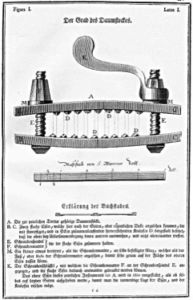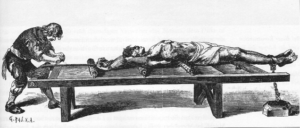By Sheridan Lea (Guest Contributor)
 During the 16th and 17th centuries in France, what kinds of torture were usually used, and were they really severe enough to require a physician? A brief exploration of a few common torture methods might help answer that question.
During the 16th and 17th centuries in France, what kinds of torture were usually used, and were they really severe enough to require a physician? A brief exploration of a few common torture methods might help answer that question.
Thumbscrews
Almost exactly what they sound like they would be, thumbscrews place the thumbs of the accused in between studded boards and gradually tightened. This form of torture is sometimes depicted to include the binding of the accused so as to keep him still during the procedure. During this method, the gradual pressure from the studs likely broke the bones in the accused’s thumb, if given a long enough amount of time or a high enough amount of pressure.
The Rack
A common method of torture, the rack effectively stretched the accused, pulling him apart little by little. An individual’s limbs would be tied to ropes which would then be cranked, tightening the rope, and thus stretching the limbs away from the trunk of the body. To increase the pain felt by an individual, and force him to confess to his crimes, this method was occasionally intensified by adding an element of fire. As a suspect was on the rack, an interrogator would burn the sides of the accused with a torch. Supposedly, it was possible to hear the pops as the joints of the accused were being pulled from their sockets.

Hand-binding
This method of torture was usually reserved for women and children. Much like the thumbscrew method, hand-binding was just that. The tightness varied depending on the severity of the case, the hands of the accused were tied very tightly with cords during interrogation. If the crime were severe, sometimes the hands would be extremely tightly bound, only to be unbound and then bound once again with the same or possibly greater tightness. In extreme cases, hand binding could be coupled with the burning of the soles of the feet. In this case, the suspect’s feet would be lit on fire after being covered in a flammable substance.
As evidenced by the different methods described, there was some variability present in the harshness of each method. When a physician was present at interrogations, it was probably for use of methods like the rack, as opposed to thumbscrews. The main goal of these forms of torture was to speed up the process of confession so that the accused may be quickly sentenced for their crimes, and it was likely the fear of pain as much as the pain itself that served as a motivator for confession.
Bibliography
Langbein, John. Torture and the Law of Proof. University of Chicago Press, 1976. Pp. 16-27.
Peters, Edward. Torture: Expanded Edition. University of Pennsylvania Press, 1985. Pp. 67-69.
Bennett, Makena, “Medieval Torture: A Brief History and Common Methods” (2012). A with Honors Projects. Paper 71.
 Sheridan Lea is a senior at Vanderbilt University in Nashville, Tennessee. She studies Anthropology with a minor in French.
Sheridan Lea is a senior at Vanderbilt University in Nashville, Tennessee. She studies Anthropology with a minor in French.
